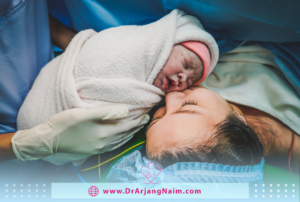Labor and delivery consist of three stages, including contraction and delivery, pushing and birth of the baby, and expulsion of the placenta. Knowing what to expect at each stage can help you feel relaxed and prepared once labor begins.
What is the first stage of labor?
The first stage of labor is the initial phase, when the cervix begins to efface (thin out) and dilate (open). It’s the longest phase of labor and consists of two parts: early and active labor.

Early labor
This phase involves the onset of regular contractions that help the cervix efface and dilate. Contractions during early labor are typically mild and may start irregularly, becoming more consistent over time. The cervix gradually opens to around 3-4 centimeters during this stage. It’s common for this phase to last for several hours. It’s a good time for the expectant mother to rest, eat light meals, stay hydrated, and practice relaxation techniques.
Active labor
Active labor begins when the cervix is around 6 centimeters dilated and continues until it reaches full dilation at 10 centimeters. Contractions become more intense, longer, and closer together during this phase. The expectant mother might feel a sense of urgency, and the focus often shifts from relaxation to coping with stronger contractions. This phase typically progresses more rapidly than early labor, and it’s usually when the mother goes to the hospital or birthing center if she’s not already there.
The first stage of labor can vary in duration for each woman and each pregnancy. Expectant mothers must stay in touch with their healthcare provider or midwife during this time, especially as labor progresses and contractions intensify.

What is the second stage of labor?
The second stage of labor begins when the cervix is fully dilated (10 centimeters) and ends with the birth of the baby. This phase is characterized by the active pushing efforts of the mother to help deliver the baby through the birth canal.
Key points of the second stage include:
- Full dilation: When the cervix reaches 10 centimeters, it indicates that the mother has entered the second stage of labor.
- Pushing: The mother will experience a strong urge to push as the baby moves further down the birth canal. This pushing helps to guide the baby through the pelvis and ultimately leads to the birth.
- Baby’s descent: The baby will continue to move down the birth canal with each contraction and push from the mother. Depending on the mother’s birthing experience and the baby’s position, this stage might last for varying durations.
- Delivery: Once the baby’s head emerges, the healthcare provider will guide the delivery of the baby’s shoulders and the rest of the body. At this point, the baby is born.
The second stage of labor requires considerable effort from the mother as she works with the contractions to push the baby out. Healthcare providers must closely monitor the mother and baby’s well-being during this stage. Once the baby is delivered, this stage comes to an end.
What is the third stage of labor?
The third stage of labor is the phase that begins right after the baby is born and concludes with the delivery of the placenta. This stage involves a few distinct steps:
- Delivery of the baby: This stage begins immediately after the baby is born. The healthcare provider focuses on the newborn, checking vital signs and ensuring the baby is breathing properly and in good health.
- Placental separation and delivery: The uterus continues to contract after the baby is born, causing the placenta to detach from the uterine wall. These contractions help expel the placenta and remaining membranes through the birth canal. Sometimes, mild contractions or a slight tug on the umbilical cord by the healthcare provider can aid in delivering the placenta.
- Assessment and care: Once the placenta is delivered, the healthcare team monitors the mother for any signs of excessive bleeding or other postpartum complications. They also examine the placenta to ensure it’s complete and that no parts are left behind in the uterus, which could cause issues later.
- Postpartum care: After the delivery of the placenta, attention shifts to the mother’s recovery. The healthcare team provides care and support, helping the mother to bond with her newborn and ensuring she is comfortable and stable.
This phase is critical for monitoring and ensuring the mother’s well-being after giving birth. While it usually happens shortly after the baby’s arrival, the duration can vary. Healthcare providers pay close attention to this phase to manage complications and ensure a smooth recovery for both the mother and the newborn.

Is there a fourth stage of labor?
Yes, the “fourth stage of labor” refers to the immediate postpartum period, typically the first few hours after the delivery of the placenta. This stage focuses on the mother’s recovery and the initial adjustment for both the mother and the newborn. Key aspects of the fourth stage of labor include:
- Monitoring and stabilization: Healthcare providers continue to monitor the mother’s vital signs, such as blood pressure, pulse, and temperature, to ensure she is stable after giving birth. This stage is crucial for detecting and addressing any potential complications, particularly excessive bleeding or issues with the uterus contracting properly.
- Bonding and breastfeeding: The fourth stage is important for the mother to bond with her newborn. Skin-to-skin contact is encouraged to promote bonding and breastfeeding initiation, as this helps stimulate milk production and facilitates early breastfeeding.
- Assessment and care: The healthcare team checks the mother’s uterus to ensure it is contracting properly, which helps prevent excessive bleeding. They may also provide pain relief or medications and offer guidance on postpartum care, including managing perineal discomfort or any mother’s concerns.
- Family support and education: This stage often involves supporting the family, including partners or other support persons, and educating them about postpartum care, newborn care, and what to expect in the initial hours and days following birth.
The fourth stage of labor is an essential period for the mother’s recovery. It’s a time when the healthcare team provides necessary support, guidance, and monitoring to ensure a healthy transition for both the mother and the newborn.

When should you call a doctor about childbirth?
Calling a doctor or healthcare provider during childbirth is necessary when certain conditions or situations require medical attention or evaluation. Here are some instances when it’s important to contact a healthcare professional during labor:
- Regular Contractions: If you’re experiencing regular contractions that are increasing in intensity and occurring at consistent intervals, especially if you’re close to your due date or your water has broken, it’s time to contact your healthcare provider.
- Water Breaking: If your water breaks (rupture of the amniotic sac) or if you experience a gush or trickle of fluid from the vagina, inform your doctor, especially if you notice any discoloration or an unusual odor in the fluid.
- Decreased Fetal Movement: If you notice a decrease in your baby’s movements or don’t feel any movements for an extended period, contact your healthcare provider immediately.
- Abnormal Vaginal Bleeding: If you have heavy bleeding, bleeding with clots, or bleeding that is different from light spotting, seek medical advice promptly.
- Pain or Discomfort: Severe or continuous abdominal pain, back pain, or pelvic pressure that feels unusual or doesn’t go away with changing positions might indicate a problem and should be discussed with your healthcare provider.
- Unusual Symptoms: Any unusual symptoms like sudden swelling in your hands or face, severe headache, vision changes, or symptoms that seem concerning or out of the ordinary should prompt you to contact your doctor.
- Concerns about Labor Progress: If you have concerns about the progression of labor, or if you’re unsure whether it’s time to go to the hospital or birthing center, it’s better to seek guidance from your healthcare provider.
Remember, every pregnancy and labor are unique, so if anything feels off or raises concerns, it’s important to contact your healthcare provider promptly. They can guide and reassure you or recommend appropriate action based on your situation.
The bottom line
Your baby’s birth is near after nine months of waiting. Knowing about the signs and symptoms of natural childbirth until after the birth of the baby will make pregnant mothers feel more relaxed and make this experience as safe as possible.
Additional questions
- How long does labor last?
On average, for first-time mothers, active labor can last around 8-12 hours but can extend up to 18 hours or more. Active labor might be shorter for subsequent pregnancies, often around 5-6 hours. However, these timeframes are approximate averages and labor duration varies greatly. Some women experience shorter labor of a few hours, while others may have longer labor lasting more than 24 hours.
- What do contractions feel like?
Contractions during labor feel like intense, rhythmic waves of tightening or cramping sensations in the lower abdomen or back. Often compared to strong menstrual cramps, they start mildly and grow in intensity, gradually becoming more frequent and powerful. Some women may feel them primarily as a tightening sensation, while others might experience intense back pain.
- What is precipitous labor?
Precipitous labor refers to an unusually fast childbirth, typically lasting less than three hours from the start of contractions to the baby’s birth. Rapid and intense contractions mark it as quick cervical dilation and swift delivery. While it might seem favorable, this rapid pace can pose risks, including increased discomfort for the mother, potential tearing, fetal distress, and a higher chance of postpartum bleeding.
- What is prodromal labor?
Prodromal labor feels like real contractions but doesn’t lead to significant cervical changes needed for childbirth. It can be exhausting and confusing, lasting hours or days. Consulting a healthcare provider helps distinguish it from active labor.
- What is chorioamnionitis?
Chorioamnionitis is a bacterial infection in the amniotic fluid and fetal membranes in the uterus. It occurs when bacteria from the vagina enter the uterus, often due to prolonged labor or ruptured membranes.
References
https://www.nhs.uk/pregnancy/labour-and-birth/what-happens/the-stages-of-labour-and-birth/
https://www.webmd.com/baby/pregnancy-stages-labor
https://my.clevelandclinic.org/health/symptoms/22640-stages-of-labor




